Shimano Components Groups for Road Bikes: A Comprehensive Overview
Shimano is a major components company. That said, there are TONS (and I seriously mean TONS) of different options that you can choose from when you buy a component group from this maker.
Ever been confused by the different categories of components? You have every reason to be. This post, hopefully, should make everything a little bit clearer. Let me start by saying that Shimano makes pretty decent products all across the board so there is no shame if you go lower in the performance food chain. Only if you are a category 1 cyclist, a high performing age grouper or a pro would you discard the first several options but we’ll get to that. There are ways you can mix and match (referring back to the TONS of options) so you can ask your friendly bike professional for options. You will notice that Shimano uses four-digit numbers on their different groups: the smaller the number, the lower it is on the performance food chain. Price is dependent on the component materials (aluminum is going to cost less than titanium) and weight (if it’s lighter, it’s more expensive). That said, let’s start from the bottom up.
The Shimano 2200
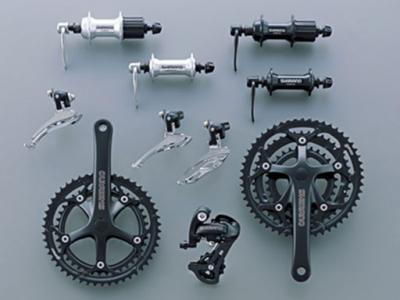
This is an entry level component group. Hands down, what you want when you want something simple to get around on and want to cut costs on the investment of a bike. This group consists of a crankset, shifters, derailleurs and hubs. Most opt to use the shifters and brakes of a higher component group to put a bike together.
The Shimano 2300
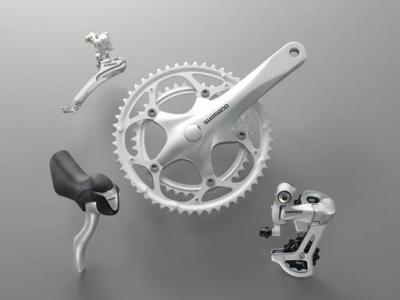
This group comes with a crankset, derailleurs and shifters. According to Shimano, the 2300 is perfect for road bikes with flat handlebars. Also entry level.
The Shimano Sora
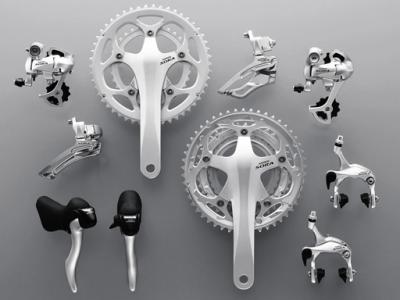
This is a group that is versatile in the fact that you can pair it up and pair it down the scale. For those of you who want to shell out a little bit more coin but don’t want to get all silly with your checkbook for a hobby that just may stay a hobby, this is a good bike component group to go for. They have mostly plastic parts in the shifters, as well as thumb buttons for gear drops.
The Shimano Tiagra
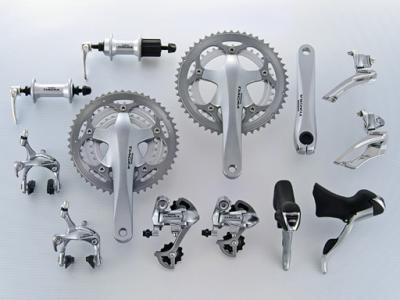
Shimano has been working on the Tiagra, making it more ergonomic. It is a sturdy workhorse of a group, with 9 speeds. Some would call this the entry level Shimano component group but it has staunch backers who consider its sturdiness and reliability a well kept secret. It is heavier than the next component groups but what it lacks in lightness, it prevails in its longevity.
The Shimano 105
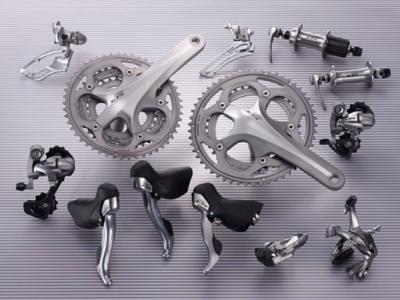
The Shimano 105 was introduced in 2011 and it comes in a 10 speed cassette with several sprocket size options. It also comes with the Hollowtech II, an innovative two-piece crank-bottom bracket that was introduced with the Dura-Ace in 2004. This technology provides for less weight and stiffness. The spacing between the chainrings has been enlarged a tad so as to reduce cross chaining. According to Shimano, this generation of 105s has dropped 30 grams in weight. The shifting is slightly better than the Tiagra, as well. It comes in either black or silver, for those of you who want their rides to match all the way through.
The Shimano Ultegra
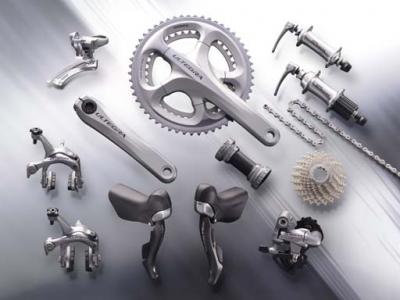
The 6700 series of the Shimano Ultegra is stylish. No two ways about it. So straight off the bat, you know there is something significantly different. It shares some of the Dura-Ace technology and has been able to reduce 150 grams of weight from its predecessor, the 6600. There is also the Di2 (Digitally Integrated Intelligence) version of this component group, which has brought electronic gear shifters to road racing. With an on-board battery pack and technology to control the chain rub, the electronic aspect quickly became a very accepted and sought-after feature. The Ultegra also incorporated the Hollowglide system, which is a hollow outer chainring, made up of two plates that are fixed together to give you a stiffer but lighter option, as opposed to a heavier, single plate, along with the Hollowtech. You can buy this group in either silver or grey.
The Shimano Dura-Ace
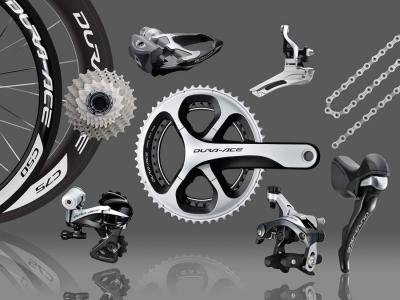
Dura-Ace was introduced by Shimano in the early 1970s and is the flagship of the Shimano fleet. The 9000 series offers an 11-speed system (meaning specially made tires=more coin to drop for your ride) and a visually striking four-armed spider crankarm instead of the normal five, as well as the Hollowtech II, which is the system with the integrated bottom bracket-crankarm set. The good people at Shimano decided that to in order to eliminate the dead areas of a pedal stroke, where pedaling efficiency was absolutely at its lowest, they increased the stiffness of the stroke and hence the four-armed spider. In comparison with the Ultegra, it is quieter on the shifts and the chain does not clamber. And of course, this group set is lighter. For the ultimate racing experience, this is the component group to buy. It is also going to be a lot more expensive than the Ultegra so if you’ve got a hole in your pocket and a LOT of Benjamins looking for a new home, you may have a winner here. The Dura-Ace 9070 is the Di2 version of this group and you can bet it’s no slacker in this department either.
It’s got an electronic microchip communication link between the levers and the front derailleur. The rear derailleurs also influence the movement of the front so that there is never any chain rub. Basically, if you change gears in the back, the front derailleur trims the chain so that there is never the danger of a chain rub. The brake hoods were also ergonomically designed so that they fit all hand sizes. The rear derailleur also has an inner cage protection system. In the likelihood of banging against it, the cage automatically moves inward to reduce the brunt of the impact. There is also a rechargeable 7.4 v lithium battery that you carry on board, with an indicator so you always know how much juice you’ve got left. It is also available for external or concealed mounting. The shifter in the TT version are buttons that sit at the end of the aerobars and you can actually program it to drop gears, according to how long you hold down on the button. You can even program the delay: how long you need to wait before it starts the gear drop.
